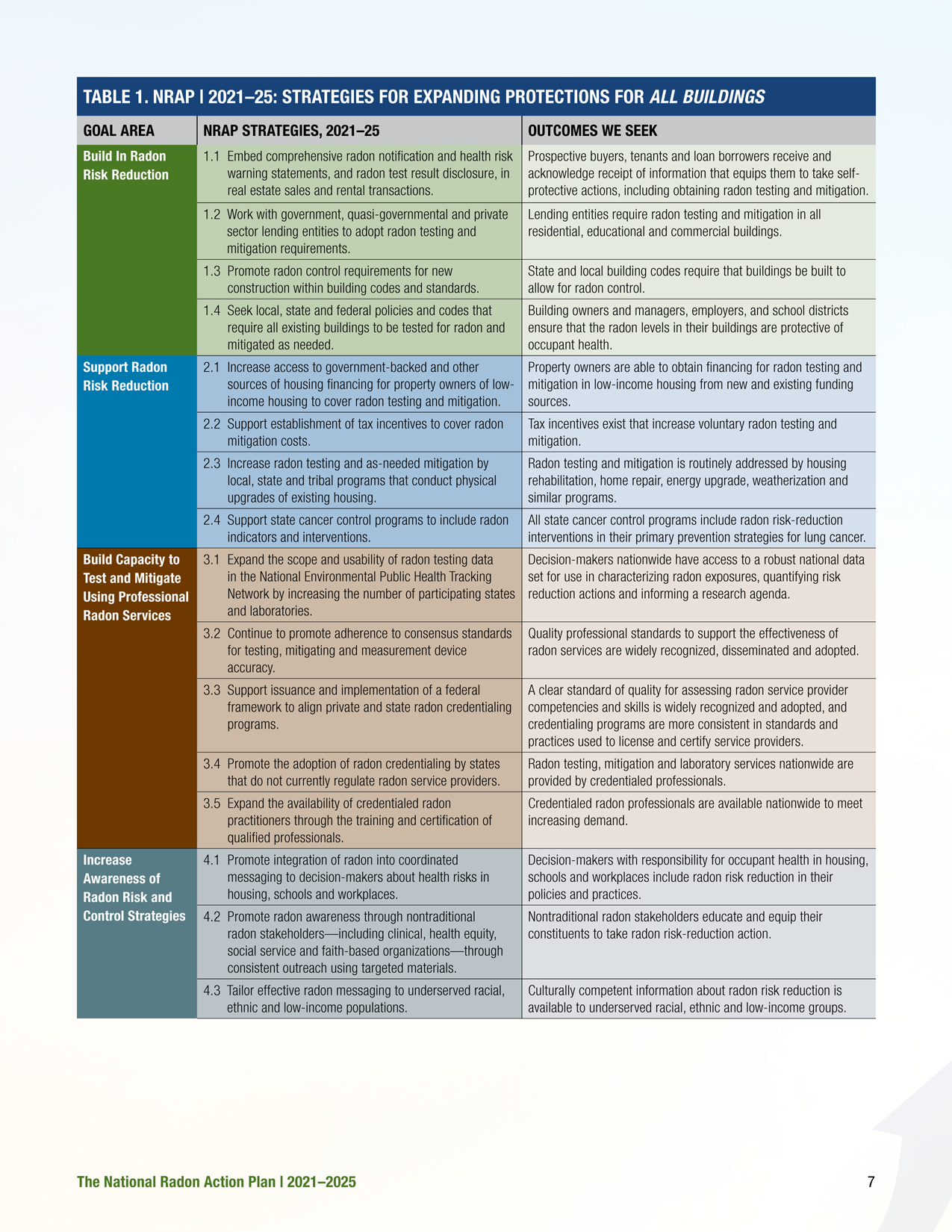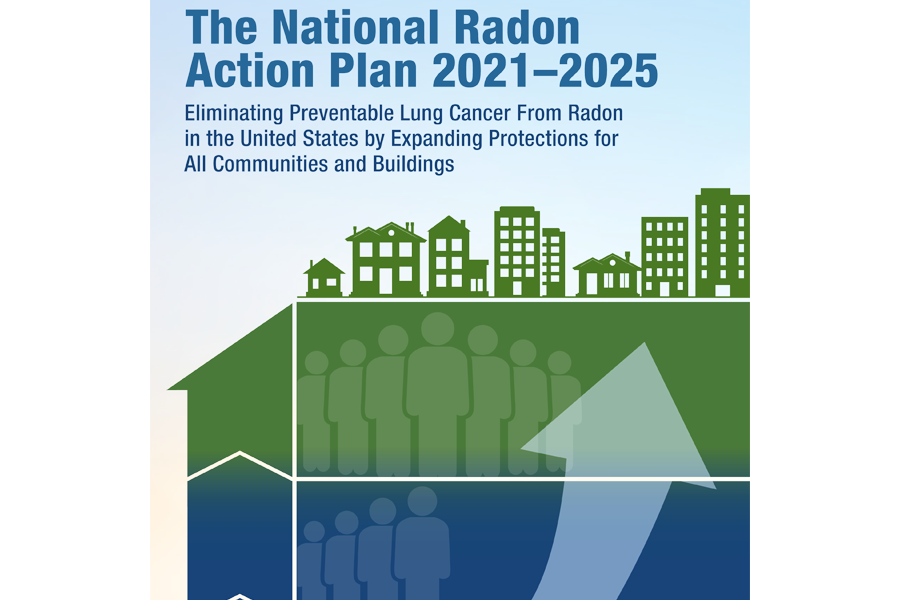(Excerpts from the The National Radon Action Plan 2021–2025 Document.)
After 5 years in partnership, the NRAP Leadership Council continues to collaborate, sharing ideas about how best to move critical, life-saving radon action forward. This multisector group shares the work—each member organization leading in its area of knowledge, responsibility and capacity—to advance four related priorities that they all share for saving lives from radon.
Building on the Federal Radon Action Plan adopted in 2011. Federal agencies made several key steps using available authority and resources to advance the battle against radon. Key federal partners leading the way in the National Radon Action Plan are the U.S. Environmental Protection Agency, U.S. Department of Housing and Urban Development and the U.S. Department of Health and Human Services, including the Centers for Disease Control and Prevention. Nine national organizations are also active leaders in the NRAP: American Lung Association, which heads the Leadership Council; American Association of Radon Scientists and Technologists; American Society of Home Inspectors; Cancer Survivors Against Radon; Children’s Environmental Health Network; Citizens for Radioactive Radon Reduction; Conference of Radiation Control Program Directors; Environmental Law Institute; and National Center for Healthy Housing.
Goal 1 Build In Risk Reduction
Rules, codes and standards that govern how buildings are financed, developed, constructed and maintained provide opportunities to require and invest in radon testing and repairs. Wherever possible, the NRAP calls for embedding radon testing, remediation and construction provisions into these requirements to integrate radon risk reduction as a standard practice in ongoing work. In NRAP | 2021–25, the document and intent of the council features four Goal Areas moving forward.
Goal Area 1 seeks to include radon requirements within real estate, including rental and mortgage transactions for all types of buildings. The goal is to maximize risk reduction for all buildings by testing, sharing information about and reducing radon risks through repairs when building transactions occur between homeowners or between landlords and renters, or when repairs and rehabilitations and construction projects are financed. The Plan remains focused on the enormous life-saving potential of protective building codes to require radon controls in new buildings and of testing and repairs of existing buildings as needed, particularly for schools and rental properties.
Goal 2 Support Radon Risk Reduction
Goal Area 2 focuses on the critical need for increasing access to government-backed and other sources of housing financing, identifying new funding sources and help for states and tribes to fund radon controls in all buildings—especially in low-income communities and communities of color—and directing cancer prevention resources toward radon risk reduction. The Plan focuses on outcomes that can be connected to preventable cancers from radon. These outcomes include working with state cancer control programs to expand radon policies; new financing and funding flowing to more testing and repairs of high radon in low-income properties; and rising priority for radon action in federal, state and philanthropic health promotion investments.
Goal 3 Build Capacity to Test and Mitigate Using Professional Radon Services
Consensus standards and guidance now exist to govern radon testing, mitigation, laboratory quality assurance and new construction methods in all buildings—all home types, schools and large buildings, and occupational settings. Radon work requires rigorous training and standards-based credentialing in accordance with the American National Standards Institute to ensure that service providers are equipped to assess radon levels, make decisions about mitigation, and, when necessary, install mitigation systems that save lives from lung cancer by reliably preventing radon from entering buildings.
Goal Area 3 builds on NRAP success by seeking to spread recognition of the standards nationwide and facilitate identification of a qualified workforce by aligning current credentialing approaches to one quality standard. The Plan prioritizes improved data collection and analysis, envisioning a landscape in which radon work can be counted on to save lives because it is conducted by credentialed professionals following national standards, and where annual radon risk reduction can be reliably estimated using a robust, nationally representative dataset.
Goal 4 Increase Awareness of Radon Risk and Control Strategies
Each year an estimated 21,000 people die from lung cancer caused by radon exposure, yet hundreds of thousands of Americans are still breathing in high levels of radon in buildings where they live, work, study and play. The risk from radon also disproportionately affects low-income households not able to test for radon and fix when necessary, the same population that suffers from poorer health and greater exposure to other residential hazards compared to more affluent individuals. The first NRAP aimed to expand coordinated messaging and outreach on radon risks across all types of buildings through trusted sources, such as health care providers and schools. Progress in this area was limited and still needs expansion.
Goal Area 4 seeks to address historic inequities in knowledge of radon risk and opportunities for risk reduction through increased engagement of intermediaries with responsibility for protecting constituents’ health in homes, workplaces, schools and childcare settings. The strategies in the Plan include outreach to target audiences that have not historically played a role in radon risk communication, such as social service providers, faith leaders and health care providers, including federally qualified and community health centers.
In 2021, the NRAP Leadership Council affirmed its commitment to expand national efforts to eliminate preventable lung cancer from radon in the United States. In implementing NRAP | 2021–25, the Council will look for strategic opportunities to guide the use of existing tools, standards, smart financing and investment to save lives; support a strong buildings workforce; and eliminate preventable radon-induced lung cancers with an increased focus on low-income communities, racial and ethnic minorities, tenants, employees, and children. For more information please review the document in its entirety.


